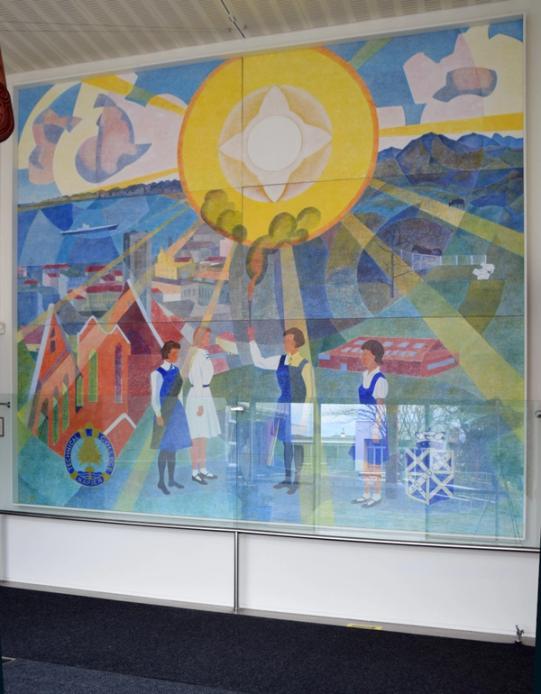Rita Angus
b. 1908d. 1970
Also known as:
- Henrietta Catherine Angus
1 Artwork
‘As a woman painter, I work to represent love of humanity and faith in mankind in a world, which is to me, richly variable and infinitely beautiful’. - Rita Angus, 1947.
Angus was born in Hastings, the eldest of seven children of Ethel Violet Crabtree and William McKenzie Angus. Her artistic ability was first recognised by G. H. Elliott, her art teacher at Palmerston North Girls' High School.
She enrolled at Canterbury College School of Art (Ilam) in 1927, to study with Leonard Booth, Cecil Kelly and Archibald Nicoll among others. Art history lectures introduced Angus to the Renaissance and medieval art that would be of enduring formal and stylistic influence and, just as important, the principles of composition from Vermeer and Cézanne. Although never completing a qualification, Angus continued to study at the university, with interruptions, until 1933.
During the late 1920s and 1930s Christchurch was an art and cultural centre. Touring exhibitions such as the Loan Exhibition of Oriental Art (1934–35) encouraged her growing interest in Far Eastern art and thought. News of contemporary art developments overseas filtered through with returning art students such as Rata Lovell-Smith and Flora Scales.
On 13 June 1930, Angus married Alfred Herbert Owen Cook though the marriage was shortlived and couple separated in 1934 and were divorced in 1939.
She signed her work Rita Cook from 1930 until 1946, but changed her name by deed poll to Henrietta Catherine McKenzie, and from 1941 sometimes signed paintings as R. McKenzie or R. Mackenzie, although she usually used the name Rita Angus.
In 1930 Angus began to exhibit with the Canterbury Society of Arts, and from 1932 with The Group. These remained the primary outlets for her work for most of her life.
In a state of near breakdown, in 1949 Angus was committed for psychiatric treatment at Sunnyside Hospital. The following year she moved to Waikanae to convalesce in the care of her parents. Angus emerged from her illness more withdrawn but just as committed to painting. During her recovery she completed some of her finest symbolic self-portraits, such as ‘Sun Goddess’ (1949) and ‘Rutu’ (1951). Angus painted at least 55 self-portraits during her career. Ranging from the coolly objective to the allegorical and symbolic, they can be read as a kind of visual diary, documenting the inner life of this very private woman.
Moving to Wellington in 1955, Angus bought an old cottage at 194A Sydney Street West, Thorndon, which became her home for the rest of her life.
Angus's first solo exhibition occured at Wellington’s Architectural Centre Gallery, when she was 49. The following year a Fellowship from the Association of New Zealand Art Societies’, enabled her to study art for a year in England and Europe. She spent most of the time in London and St Ives, looking at historical and contemporary art. This was her only overseas trip.
Back in Wellington, Angus accepted a mural commission for Napier Girls’ High School, which occupied her for most of 1960.
When Thorndon was bisected by a motorway in the late 1960s, Angus, in a spirit of protest, documented the demolition of old houses and the removal of tombstones at Bolton Street cemetery. ‘Flight’ (1968–69), one of her last major oils, is a visionary painting which combines a view of Island Bay with gravestones from the cemetery, and the flying dove, symbol of peace.
Angus entered Wellington Hospital with ovarian cancer in November 1969. She died there on 25 January 1970. Her cottage in Sydney Street later became a home for artists on yearly tenure.
~ extracts from Jill Trevelyan. 'Angus, Rita', Dictionary of New Zealand Biography, Te Ara - the Encyclopedia of New Zealand.

Rita Angus, ‘Memorial Mural’ (1960), Napier Girls High School, Ahuriri Napier
Images: Public Art Heritage Aotearoa New Zealand, 2021
- Associated Artworks

![Untitled [Napier Girls' High School]](/_next/image?url=https%3A%2F%2Fcdn.sanity.io%2Fimages%2Faem3610x%2Fproduction%2Fcd6b26f20fece3f8a233c89d78ea5c4f637a835d-842x1080.jpg%3Frect%3D0%2C119%2C842%2C842%26w%3D330%26h%3D330%26fit%3Dclip&w=750&q=75)